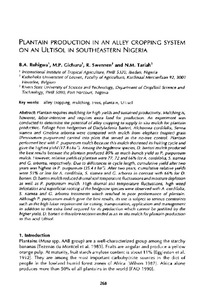| dc.contributor.author | Ruhigwa, B.A. |
| dc.contributor.author | Gichuru, M. |
| dc.contributor.author | Swennen, R. |
| dc.contributor.author | Tariah, N.M. |
| dc.date.accessioned | 2019-12-04T11:24:52Z |
| dc.date.available | 2019-12-04T11:24:52Z |
| dc.date.issued | 1995 |
| dc.identifier.citation | Ruhigwa, B.A., Gichuru, M., Swennen, R. & Tariah, N.M. (1995). Plantain production in an alley cropping system on an Ultisol in southeastern Nigeria, Alley farming research and development: Conference Proceedings of an International Conference on alley farming, Ibadan, Nigeria, 14-18 September, 1992. Ibadan, Nigeria: IITA, (p. 268-277). |
| dc.identifier.uri | https://hdl.handle.net/20.500.12478/4475 |
| dc.description.abstract | Plantain requires mulching for high yields and sustained productivity. Mulching is, however, labor-intensive and requires extra land for production. An experiment was conducted to determine the potential of alley cropping to supply in situ mulch for plantain production. Foliage from hedgerows of Dactyladenia barteri, Alchornea cordifolia, Senna siamea and Gmelina arborea were compared with mulch from elephant (napier) grass (Pennisetum purpureum) carried into plots that served as the no-tree control. Plantain performed best with P. purpureum mulch because this mulch shortened its fruiting cycle and gave the highest yield (17.8 t ha-1). Among the hegderow species, D. barteri mulch produced the best results because the plantain produced 85% as much bunch yield as P. purpureum mulch. However, relative yields of plantain were 77,72 and 66% for A. cordifolia, S. siamea and G. arborea, respectively. Due to differences in cycle length, cumulative yield after two years was highest in P. purpureum (35.4 t ha-1). After two years, cumulative relative yields were 51 % or less for A. cordifolia, S. siamea and G. arborea in contrast with 66% for D. barteri. D. barteri mulch reduced diurnal soil temperature fluctuations and moisture depletion as well as P. purpureum mulch. High diurnal soil temperature fluctuations, high weed infestation and superficial rooting of the hedgerow species were observed with A. cordifolia, S. siamea and G. arborea treatments which resulted in poor performance of plantain. Although P. purpureum mulch gave the best results, its use is subject to serious constraints such as the high labor requirement for cutting, transportation, application and management in addition to the extra land required for its production which cannot be justified by the higher yield. D. barteri is therefore recommended as an in-situ mulch for plantain production in this acid Ultisol. |
| dc.language.iso | en |
| dc.subject | Alley Cropping |
| dc.subject | Mulching |
| dc.subject | Trees |
| dc.subject | Plantains |
| dc.subject | Ultisols |
| dc.title | Plantain production in an alley cropping system on an Ultisol in southeastern Nigeria |
| dc.type | Conference Paper |
| cg.contributor.affiliation | International Institute of Tropical Agriculture |
| cg.contributor.affiliation | Katholieke Universiteit, Leuven |
| cg.contributor.affiliation | Rivers State University of Science and Technology |
| cg.coverage.region | Africa |
| cg.coverage.region | West Africa |
| cg.coverage.country | Nigeria |
| cg.authorship.types | CGIAR and developing country institute |
| cg.iitasubject | Soil Health |
| cg.iitasubject | Crop Systems |
| cg.iitasubject | Plantain |
| cg.iitasubject | Plant Health |
| cg.accessibilitystatus | Limited Access |
| local.dspaceid | 100725 |

